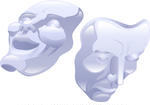With the beginning of the 2014-2015 school year brings with it a world of uncertainty for many people within the New Kensington-Arnold school district. With the recent move by the district to reorganize the schools, we will see the 7th and 8th grades move from the former Valley Middle School to what is now being called Valley Jr./Sr. High School. While these students are still considered junior high school students, their presence within the larger school community can not be ignored.
With this change comes an enormous opportunity for our organization to open the world of performing arts to a much larger base – both from a student-participation stand point and from an audience stand point. But for now, let’s focus just on what inclusion in the Drama Club can mean for everyone.
Our group is all about inclusion – we have never turned away a student who wanted to participate in our theatre arts program, and do not intend to start that now. Our decision was based solely on having a unique opportunity to expose more people to theatre than we have had in the past. Since the reorganization of the VHS drama program in the late 1990’s, the drama club has given over 2,000 students the opportunity to experience the thrill of participating in a live performance, but as the years have gone on, the average number of students participating in the program has seen a steady decline. How would you feel if you were in a school that had a program such as ours, but were told that because you were ‘too young’ you could not participate. We don’t want any student to ever feel that they are not able to participate in something as wonderful, exciting and fulfilling as this. And this year, we have expanded our program to once again present two shows, giving anyone who wants to participate the opportunity.
Let’s take a brief look at what benefits participating in a school theatre program has on students (thank you to the American Alliance for Theatre and Education for this information):
- Students involved in drama performance coursework or experience outscored non-arts students on the 2005 SAT by an average of 65 points in the verbal component and 34 points in the math component
- Drama activities improve reading comprehension, and both verbal and non-verbal communication skills
- Drama helps to improve school attendance and reduce high school dropout rates
- A 2005 Harris Poll revealed that 93% of the public believes that arts, including theatre, are vital to a well-rounded education
- Drama can improve skills and academic performance in children and youth with learning disabilities
In our community, it is our responsibility to provide every opportunity for let our students shine. Further, ‘since the implementation of the No Child Left Behind Act, there has been a national focus on closing the “achievement gap” between students of varying abilities, socioeconomic status, and geographies among other factors that may directly or indirectly affect a student’s academic success. The arts, including drama, address this issue by catering to different styles of learning, and engaging students who might not otherwise take significant interest in academics. Additionally, research indicates that drama courses and performance have a particularly positive effect on at-risk youth and students with learning disabilities.
- A study published in Champions of Change (1999) cites theatre arts, including performance, classes, and participation in a drama club, as a source for “gains in reading proficiency, gains in self-concept and motivation, and higher levels of empathy and tolerance towards others” among youth of low socio-economic status
- Drama activities can improve and help to maintain social and language skills of students with learning disabilities and remedial readers
- Improvisational drama contributes to improved reading achievement and attitude in disadvantaged students’
And if that isn’t enough, let’s take a look at the public opinion of arts, specifically drama, in our students’ education:
Statistics show that most of the public feels the performing arts play a significant role in our culture and communities and are important to America’s youth. In 2002, the Performing Arts Research Coalition (PARC) conducted surveys in 10 major metropolitan areas regarding the role of Performing Arts in their lives and communities . They discovered that at least 90 percent of respondents from each metropolitan area agreed or strongly agreed that the performing arts contribute to the education and development of children. More than 60 percent of respondents in each location who had children aged 13 and older strongly agreed that the performing arts contribute to the education and development of children.On average, just over half of respondents had attended a live theatre performance in the past year. According the to surveys in all 10 cities, live theatre is the most commonly attended type of performance.
According to a May 2005 Harris Poll :
- 93 percent of Americans believe that the arts are essential to a complete education
- 79 percent feel that the arts should be a priority in education reform
- 79 percent consider the issues facing arts education to be significant enough to merit their personally taking action
So there you have it. We want to continue to give our students every opportunity to shine, both on the stage and off, and we are thrilled to welcome this new group to our family, and we hope that all of our students from previous years who are still at VHS will continue to support and participate in our club.
We hope you agree – please come out and talk with us and see what is coming up for VHS drama this year when we have a meeting for all students and parents interested in joining our organization at 7:00 on September 15th in the VHS auditorium. As always, your comments are welcome.


